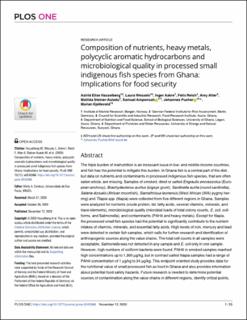| dc.description.abstract | The triple burden of malnutrition is an incessant issue in low- and middle-income countries, and fish has the potential to mitigate this burden. In Ghana fish is a central part of the diet, but data on nutrients and contaminants in processed indigenous fish species, that are often eaten whole, are missing. Samples of smoked, dried or salted Engraulis encrasicolus (European anchovy), Brachydeuterus auritus (bigeye grunt), Sardinella aurita (round sardinella), Selene dorsalis (African moonfish), Sierrathrissa leonensis (West African (WA) pygmy herring) and Tilapia spp. (tilapia) were collected from five different regions in Ghana. Samples were analyzed for nutrients (crude protein, fat, fatty acids, several vitamins, minerals, and trace elements), microbiological quality (microbial loads of total colony counts, E. coli, coliforms, and Salmonella), and contaminants (PAH4 and heavy metals). Except for tilapia, the processed small fish species had the potential to significantly contribute to the nutrient intakes of vitamins, minerals, and essential fatty acids. High levels of iron, mercury and lead were detected in certain fish samples, which calls for further research and identification of anthropogenic sources along the value chains. The total cell counts in all samples were acceptable; Salmonella was not detected in any sample and E. coli only in one sample. However, high numbers of coliform bacteria were found. PAH4 in smoked samples reached high concentrations up to 1,300 μg/kg, but in contrast salted tilapia samples had a range of PAH4 concentration of 1 μg/kg to 24 μg/kg. This endpoint oriented study provides data for the nutritional value of small processed fish as food in Ghana and also provides information about potential food safety hazards. Future research is needed to determine potential sources of contamination along the value chains in different regions, identify critical points, and develop applicable mitigation strategies to improve the quality and safety of processed small fish in Ghana. | en_US |
